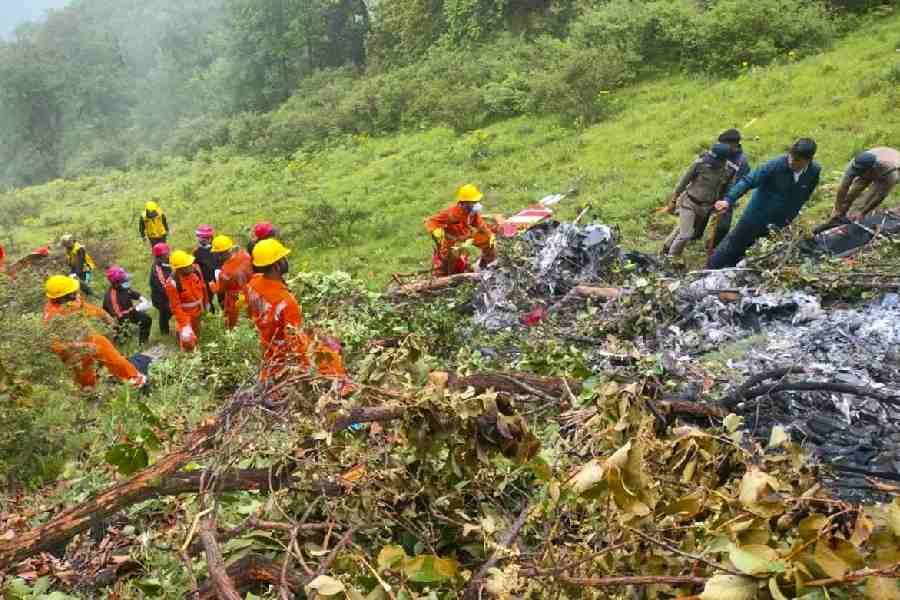 |
| The boat |
Circa 2,500 BC: Boats made of reed coated with bitumen criss-cross the Arabian Sea, driving trade between the Majan kingdom of Oman and the Gujarat ports of Meluhha (Indus Valley civilisation).
AD 2005: A boat of reed and bitumen sails from Oman amid much fanfare, heading for Bet Dwarka in an effort to retrace the 4,500-year-old Early Bronze Age sea trade route. It sinks within hours, leaving its international crew of expert navigators and archaeologists to be rescued by an Omani naval ship accompanying the boat.
Sept. 9: The Bronze Age navigators relied on “the stars, wind and wave direction”, the colour of the sky and sea. They carefully watched the flight of the birds as they braved the waters to keep the ancient economy running so that stomachs could be filled in their homeland.
The modern-day expedition, celebrating 50 years of Delhi-Muscat diplomatic ties, “hoped” to follow the same techniques but had fitted out its 12 m by 3.8 m boat with radars and safety equipment as a precaution.
It didn’t help.
“On the night of departure, the vessel, overwhelmed by the might of the sea and strong winds, went under,” the release from Oman’s heritage and culture ministry sounded suitably grave.
Co-sponsored by the ministry and the Archaeological Survey of India, the boat set sail yesterday from Sur, about 340 km from Muscat, and headed for Mandvi in Gujarat with a stopover in Bet Dwarka.
The end came after 15 nautical miles, three per cent of the 500 nautical mile distance.
“Every challenge we face will help us appreciate the extraordinary prowess, skill, knowledge and experience of ancient Omani boat builders and seafarers,” an official added.
The lesson in humility was a bonus; what the voyagers had meant to learn, according to Gujarat archaeology director Yudhbir Singh Rawat, was whether the ancients took a coastal or a deep-sea route. Last night’s failed mission had taken the latter.
The route may be blamed, but not, perhaps, the boat. Though Tom Vosmer, the Australian who designed the vessel and was among the crew of eight, insisted “this is not a replica”, archaeological evidence suggests the Majans’ boats may not have been all that different.
Italian archaeologist Maurizu Tosi had discovered 300 impressions of bitumen slabs dating back to 2300-1210 BC in the Sur peninsula.
“The bitumen showed the impressions of bound reeds, rope (probably of date palm fibre) lashings and woven mats on one side, and the remains of barnacles or impressions of fully-grown barnacles on the opposite side? indicating continuous submersion for at least three months,” Vosmer said.
Tosi also found an ancient artist’s boat sketches. Three triangular anchors dating back to 1400-1500 BC were dug up near the Dwarka temple and also in Syria, said archaeologist Bhartiben Shelat.
Combined with evidence from iconography and cuneiform texts, the data helped build the “hypothetical” boat. The building was done by a joint Omani, Italian and French mission.
The crew was even more international: Vosmer, Peter Manthorpe (sailing master, Australia); Alok Tripathi (archaeologist, India); William McGrath (navigator, US); Luca Belfioretti and Alessandro Ghidoni (both construction supervisers from Italy); Hussein Al Baloushi (Royal Navy, Oman) and Nasser Said Rashid Al Araimi (Royal Yacht Squadron, Oman).
The boat carried what the ancient Majans would have: copper ingots, dates, dried fish, pottery, honey, incense, lime, salt, shells, steatite vessels and hides. As a symbol of modern Indo-Omani ties, it also carried urea from a $1-billion joint-venture fertiliser company that recently began production in Sur.
The Majans probably returned with cotton, silver, ivory and semi-precious stones.
Excavations prove the trade was successful. Shards of Harappan pottery, beads and combs were found in Oman’s Ras-al-Jinz, and remnants of Majan boats in Oman’s Sur peninsula as well as the Harappan sites of Bet Dwarka and Lothal.
Lothal has thrown up the Persian Gulf Seals, terracotta models of Egyptian mummies and boats and a massive brick structure identified as a dockyard with some stone anchors nearby.
A Sumerian text mentions a Mesopotamian king of the time who travelled to Dilaman (modern Bahrain), Majan and Meluhha (India) to buy vessels.
Vosmer said the boat’s maximum speed was 5 knots or nautical miles per hour. “Since we will use only primitive methods of navigation, we could take anything from 10 days to two weeks.”
He said that during the voyage, the crew would live on a Bronze Age diet of dates, pulses, dried fish, honey, bread and water, some of it carried in the traditional way -- in goatskins.
The crew has been spared that torture. All of them are safe and on better diet on board the Fulk al Salamah.











